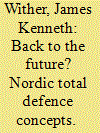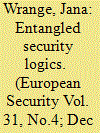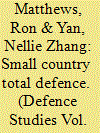|
|
|
Sort Order |
|
|
|
Items / Page
|
|
|
|
|
|
|
| Srl | Item |
| 1 |
ID:
171141


|
|
|
|
|
| Summary/Abstract |
Russia’s aggression against Ukraine has forced the greatest a re-appraisal of European security since the end of the Cold War. In the Nordic region, this has led to preparations for great power armed conflict in the region after a long period of strategic neglect. All three of the Nordic states examined here, Finland, Sweden and Norway, have adopted so called total defence policies. Total defence combines the armed forces and civil society in a comprehensive whole of society approach to security intended to deter an attack by making a target state a very challenging prospect for an aggressor. Finland retained a total defence policy after the Cold War, but has had to re-examine its utility for the contemporary threat environment. For Norway and Sweden, total defence means significant challenges reviving Cold War era planning in a very different security and societal context. This study examines current Nordic security concepts through the critical, elements of total defence policies: national resilience and territorial defence. It also addresses the role that alliances and partnerships play in contemporary Nordic total defence planning. An important question is the extent to which these total defence concepts effectively address the perceived political and military threat from Russia.
|
|
|
|
|
|
|
|
|
|
|
|
|
|
|
|
| 2 |
ID:
187502


|
|
|
|
|
| Summary/Abstract |
Entangled logics, which attribute meaning to security, characterise the contemporary security field, bringing about broad comprehensions and ambiguous concepts. Civil defence has (re)surfaced as one such concept that is broadly conceived in the official discourses produced by decision-makers. Since security is ultimately enacted by practitioners, alias decision-takers, their interpretations of concepts significantly shape policy actions. Therefore, this article moves from decision-makers’ discourses to decision-takers’ interpretations and explores the divergent understandings of the concept of civil defence in Sweden. Applying a discursive approach to data gathered through official documents and interviews with 21 national agency representatives, organised under five societal sectors, it finds that two main interpretations emerge, across and within sectors. These are conceptualised as “territorial civil defence” and “societal civil defence”, linked, respectively, to logics of “territorial security” and “societal security”. These differences, as is argued, potentially challenge agency collaboration and eventual policy coherence in terms of policy aims, governance and venues for cooperation. Hence, the study highlights the complex constraints that contemporary security discourses set in the policy sphere. It concludes that in order to effectively meet and capture the complexity of contemporary security, disentanglement of the field’s concepts, both in theory and in practice, is needed.
|
|
|
|
|
|
|
|
|
|
|
|
|
|
|
|
| 3 |
ID:
079718


|
|
|
|
|
| Publication |
2007.
|
| Summary/Abstract |
This paper explains how the tiny city-state of Singapore successfully developed
a strategy and capability to defend both its territorial integrity and its
vital national interests in a region where it was effectively surrounded by
potentially hostile states. Based on the island-state's 'Total Defence'
concept, scarce resources have been harnessed to construct a consensualsociety, a powerful economy, and a strong military, all committed to the
defence of sovereignty. The constraints of 'small size' have been overcome
by several factors: a sensible and visionary defence policy; a conscription and
reservist manpower model; a 'dual-use' approach to defence industrialisation;
a force multiplier policy aimed at exploiting Singapore's revealed
technological comparative advantage; and a training and international
diplomacy regime fostering friendly relations with some of the world's most
powerful nations. Singapore's national security strategy has led to this small
country becoming the most militarily strong nation in South-East Asia
|
|
|
|
|
|
|
|
|
|
|
|
|
|
|
|
|
|
|
|
|